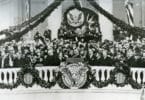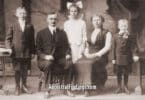Early Life and Background
Millard Fillmore was born on January 7, 1800, in a log cabin in Cayuga County, New York. He was the second of nine children born to Nathaniel Fillmore and Phoebe Millard. The Fillmore family lived in poverty, and Millard’s early life was characterized by hard work and limited educational opportunities. Despite these challenges, Fillmore strongly desires to learn and improve his circumstances.
Fillmore’s education began in a one-room schoolhouse but was largely self-taught. At 15, he was apprenticed to a clothmaker, a job he found unsatisfying. Determined to pursue a different path, Fillmore saved money to buy out his apprenticeship and later attended the New Hope Academy. His dedication to his studies paid off, and he eventually secured a position as a law clerk, allowing him to pursue a career in law.
Early Political Career
Fillmore’s political career began in the New York State Assembly, where he served from 1829 to 1831. His tenure in the assembly was marked by his support for internal improvements and his advocacy for establishing a public school system. Fillmore’s commitment to education would remain a consistent theme throughout his career.
In 1832, Fillmore was elected to the U.S. House of Representatives as a member of the Anti-Masonic Party, reflecting his opposition to the secretive Masonic Order. He later aligned himself with the Whig Party, attracted by its economic development and modernization support. Fillmore served in Congress from 1833 to 1835 and again from 1837 to 1843. During his time in the House, he became known for his financial expertise and work on the Ways and Means Committee.
Rise to National Prominence
Fillmore’s national prominence grew when he was selected as the Whig candidate for vice president in the 1848 election, running alongside Zachary Taylor. The Whig Party sought to balance the ticket by pairing Taylor, a Southern slaveholder and war hero, with Fillmore, a Northerner with strong anti-slavery leanings. The strategy proved successful, and Taylor and Fillmore won the election.
As vice president, Fillmore presided over the Senate during intense sectional conflict. The issue of slavery in the newly acquired territories from the Mexican-American War dominated the national debate, and Fillmore’s role as a mediator in the Senate became increasingly important.
Presidency (1850-1853)
Assumption of the Presidency
Millard Fillmore became president unexpectedly after the death of Zachary Taylor on July 9, 1850. His ascension to the presidency came at a critical juncture in American history, as the nation faced growing tensions over the issue of slavery. Fillmore’s first major task as president was to address the contentious debates surrounding the Compromise of 1850.
The Compromise of 1850
The Compromise of 1850 was a series of legislative measures to resolve the disputes between free and slave states. The compromise included the admission of California as a free state, the establishment of territorial governments in Utah and New Mexico with the question of slavery to be decided by popular sovereignty, the abolition of the slave trade in Washington, D.C., and the introduction of a more stringent Fugitive Slave Law.
Fillmore played a crucial role in the passage of the compromise, working with key senators such as Henry Clay, Daniel Webster, and Stephen A. Douglas to navigate the legislative process. Despite his personal anti-slavery views, Fillmore believed that the compromise was necessary to preserve the Union. He signed the measures into law, hoping to alleviate sectional tensions and maintain national unity.
Enforcement of the Fugitive Slave Law
One of the most controversial aspects of the Compromise of 1850 was the Fugitive Slave Law, which required the return of escaped slaves to their owners and imposed severe penalties on those who aided fugitives. Fillmore’s enforcement of the law drew sharp criticism from abolitionists and further polarized the nation. While Fillmore saw the law as a necessary concession to the South, its harsh provisions and aggressive enforcement exacerbated the growing divide between North and South.
Foreign Policy and Domestic Affairs
Fillmore’s presidency also saw significant developments in foreign policy. He pursued a policy of expanding American influence in the Pacific, including the opening of Japan to Western trade through the efforts of Commodore Matthew Perry. Fillmore’s administration also sought to strengthen economic ties with Latin America and worked to resolve territorial disputes with Great Britain over Central America.
Domestically, Fillmore supported infrastructure improvements and economic development. He advocated for constructing a transcontinental railroad and expanding the telegraph system, believing that such advancements were essential for the nation’s growth and prosperity.
Personal Life and Character
Millard Fillmore married Abigail Powers in 1826, and the couple had two children, Millard Powers Fillmore and Mary Abigail Fillmore. Abigail significantly influenced Fillmore, sharing his passion for education and intellectual pursuits. She established the first White House library and was known for advocating women’s education.
Fillmore was known for his modesty, diligence, and pragmatic approach to governance. His rise from humble beginnings to the presidency exemplified the American ideal of self-made success. However, his pragmatic stance on contentious issues, particularly slavery, often placed him in the crossfire of both abolitionist and pro-slavery factions.
Interesting Aspects of Fillmore’s Presidency
The Opening of Japan
One of Fillmore’s notable foreign policy achievements was the opening of Japan to Western trade. In 1852, Fillmore dispatched Commodore Matthew Perry to Japan with a letter requesting the establishment of trade relations. Perry’s mission, completed under Fillmore’s successor, Franklin Pierce, led to the signing of the Treaty of Kanagawa in 1854, ending Japan’s centuries-old policy of isolation and opening the country to international commerce.
Fillmore’s Role in the Smithsonian Institution
Fillmore played a key role in establishing the Smithsonian Institution. He supported the acceptance of James Smithson’s bequest to the United States and advocated for the creation of an institution dedicated to increasing and disseminating knowledge. The Smithsonian Institution, founded in 1846, remains a legacy of Fillmore’s commitment to education and scientific advancement.
Legacy and Impact
Millard Fillmore’s presidency is often overshadowed by his era’s more dramatic events and figures. However, his efforts to navigate the complex and contentious issues of his time significantly impacted the nation’s trajectory. The Compromise of 1850, despite its flaws, temporarily alleviated sectional tensions and delayed the onset of the Civil War.
Fillmore’s enforcement of the Fugitive Slave Law, while controversial, highlighted the deepening divide over slavery and underscored the challenges of maintaining national unity. His foreign policy achievements, particularly the opening of Japan, expanded America’s global influence and set the stage for future economic and diplomatic endeavors.
Post-Presidency
After leaving office in 1853, Fillmore retired to Buffalo, New York, where he remained active in public affairs. He ran for president again in 1856 as the candidate of the Know Nothing Party, a nativist political movement, but was unsuccessful. Despite his defeat, Fillmore continued participating in civic and philanthropic activities, including supporting the Buffalo Historical Society and the University at Buffalo.
Fillmore’s later years were marked by his efforts to preserve the Union and promote education. He remained a respected figure in his community until his death on March 8, 1874.
Conclusion
Millard Fillmore’s life and presidency offer a nuanced and complex portrait of a leader navigating one of the most turbulent periods in American history. From his humble beginnings to his unexpected rise to the presidency, Fillmore’s journey is a testament to the values of perseverance, pragmatism, and dedication to public service.
While his presidency was marked by significant challenges and controversial decisions, Fillmore’s efforts to address the contentious issue of slavery and his commitment to national unity left a lasting impact. His contributions to foreign policy, infrastructure development, and education remain important aspects of his legacy.
Millard Fillmore’s story is a compelling chapter in the broader narrative of the United States, highlighting the nation’s struggles, achievements, and enduring quest for unity and progress.
If you want to learn more, here are five highly recommended books about Millard.
Millard Fillmore: Biography of a President by Robert J. Rayback
This comprehensive biography offers a detailed look at Fillmore’s life, from his humble beginnings to his presidency. Robert J. Rayback provides a thorough analysis of Fillmore’s political career and his impact on American history.
Millard Fillmore by Paul Finkelman
Part of The American Presidents Series, this concise biography by Paul Finkelman examines Fillmore’s life and presidency, providing insights into his political decisions and legacy. It’s an accessible read covering the key aspects of Fillmore’s tenure.
The Remarkable Millard Fillmore: The Unbelievable Life of a Forgotten President by George Pendle
This engaging and somewhat humorous biography by George Pendle presents Fillmore’s life and achievements in a lively manner, making it an enjoyable read while offering substantial information about his contributions.
Millard Fillmore: The American Presidents Series: The 13th President, 1850-1853 by Paul Finkelman
Another insightful work by Paul Finkelman, this book is part of The American Presidents Series and provides a focused look at Fillmore’s presidency, exploring his leadership style and the key events of his administration.






